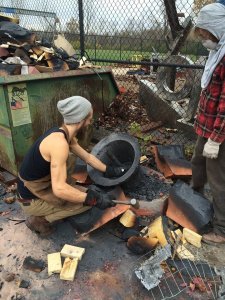A Ringing Tribute
OWU senior casts 200-pound bell for House of Peace and Justice’s 30th anniversary

Ohio Wesleyan University student Gwen Kelling ’16 has designed and cast a peace bell to display at the House of Peace and Justice to commemorate the 30th anniversary of the P&J community.
Weighing an estimated 200 pounds, Kelling’s 21-inch diameter bell is the largest sculpture ever produced at Haycock Hall, setting a size record for iron casting at Ohio Wesleyan.
“I’d like to honor time spent at P&J by the strong voices that live and have lived there,” says Kelling, a double-major in botany and fine arts with a concentration in sculpture. She has lived in the P&J small living unit (SLU) since her sophomore year.
“Bells have been used throughout history to celebrate accomplishments and to mourn losses,” Kelling says, adding that even if the structure someday changes, “having a bell at the site would allow members of the P&J community to assemble for common causes and for the house to still have a sort of ‘voice.’ ”
Kelling, a native of Morrow, Ohio, researched bell-founding over the summer before undertaking her bell project this fall. She visited The Verdin Company, a bell foundry in Cincinnati, where she observed the casting of five large bronze bells, each weighing about 500 pounds.
“As I get closer to graduation, I’ve been interested in locating art foundries in my area and was fascinated with the scientific, musical, and aesthetic skill displayed at the company,” she says.
Kelling’s bell, which rings the musical note D, has the Latin text, “a coeli usque ad centrum,” inscribed on its surface. The phrase, which means “from the sky to the center,” was used in Roman property law to describe a landowner’s investment in a home as spanning both above and below the surface.
The process Kelling used to create her bell mimics methods used in Western Europe since the 12th century. She outlined the beginning shapes of the bell by rotating a piece of wood called a strickle around a cone of clay to scrape the cone’s surface into a bell shape.
The bell is made from recycled scraps of iron collected around Delaware. The designs on the upper part of the bell are made from a charcoal rubbing composed of the decorations on a radiator in Kelling’s bedroom ‒ the same room that four P&J foundrymen inhabited in the past.
To accommodate the bell’s size, OWU fine arts professor Jonathan Quick and Kelling had to increase the capacity of the Haycock foundry at almost every stage of the process, including soaking plaster molds, pouring wax, moving and packing sand molds, and pouring the molten iron itself. They used a 300-pound capacity holding ladle donated by the Liberty Casting Company in Delaware.
“I have a few friends who are alumni of the house who also took metal casting classes at Haycock Hall, so the bell is also meant to celebrate that relationship between our resident activists and the foundry,” Kelling says. “Activism and metal casting involve a common sense of vitality, invention, and dedication that compelled me throughout the project.”
The House of Peace and Justice, also known as the Perkins House, is the former residence of Hiram Perkins, a professor of mathematics and astronomy at Ohio Wesleyan from 1857 to 1907. To display the bell, Kelling hopes to install a brick pedestal or a small bell tower in P&J’s yard.
Kelling says she was drawn to OWU for the liberal arts curriculum and the interdisciplinary spirit of academic conversation. As for her plans after graduation, she currently is applying to the bell foundry in Cincinnati and researching other art foundries. Kelling also is finalizing her botany research in an independent study and intends to take the GRE (graduate record examinations) in case she later decides to pursue postgraduate work in botany.
Kelling says her favorite aspect of living in P&J is experiencing the support the housemates give to one another’s causes and ambitions.
“We all have this deep connection to the peace our house has fostered for years, the joy it has fostered in all of its members,” Kelling says. “I see in my housemates the same latent drive to change the world that brought me to P&J in the first place.”
